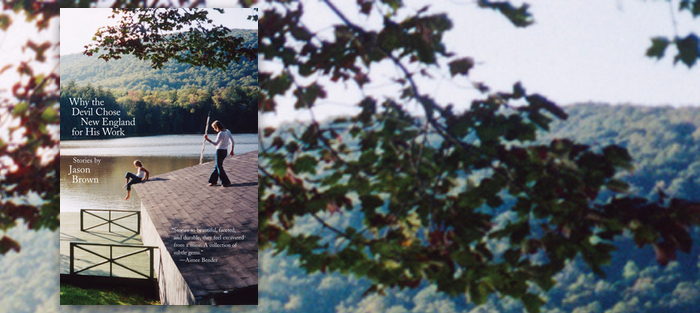The eleven stories in Jason Brown’s latest collection, Why the Devil Chose New England for His Work, are linked not so much by character as by geography and tone. Set in and around the fictional town of Vaughn, on the banks of the Kennebec River in central Maine, Brown’s stories contain characters driven by duty and guilt down paths furrowed by their own lapses and eccentricities. A cloud of fatalism hangs over many; the weight of the past—personal, familial, historical—presses constantly at their backs. “Despite what our father had always said,” the narrator of “The Plains of Abraham” confesses, “I didn’t believe that a single event could determine the course of our lives. It seemed more likely that we were swept up in the momentum of currents that reached back farther than we could see.”
Brown’s New England is a land with a long memory, deeply imbued with the legacy of Puritanism and its doctrine of Original Sin, and in Why the Devil Chose New England for His Work, history, geography, and character are inextricably linked. Setting reflects character reflects setting. In “Trees,” a story with the clean lines and inevitable momentum of allegory, an old woman is unable to deter her nephew from cutting down the family’s tract of old-growth forest—and as the ancient trees fall, the woman’s past is slowly bared to the reader.
Throughout the collection, Brown proves sensitive both to the way his characters perceive setting and the ways they perceive themselves as part of it. Consider, from “The Lake,” a crisp metaphor comparing a lake to “a glassy eye peering up out of the earth.” But finer than the comparison itself is the way Brown nests it within the point-of-view of a thirteen-year-old girl—
Dennis stood up and dove into the water, his legs kicking down until she had to look away her heart pounded so fast. For a moment she was outside her body, above the lake looking down at herself, a girl she didn’t know, sitting alone in a canoe. There were other people on the lake, but in her mind she was looking at a girl in a canoe alone on a lake. It had never seemed odd before to live next to such a large body of water, like a glassy eye peering up out of the earth.
—and the way that this metaphor reverberates at the story’s end, when the girl, hidden in the undergrowth, observes Dennis from afar. She is as watchful and unblinking as the lake, and the effect is—for reasons that can’t be fully explained without reconstructing the story word-for-word—quietly devastating.
Brown’s meticulous command of point-of-view is evident elsewhere, as well. “She,” the collection’s opening story, begins in first-person but soon shifts to a head-hopping third-person that travels freely around Vaughn as residents search for, and speculate on the fate of, a high-school girl named Natalie, the titular “she,” who has run off with a boy from the wrong side of the town’s single railroad track. The story’s final paragraphs snap rapidly back and forth between Natalie, her boyfriend, and the members of the posse Natalie’s father has mustered to search for her. What may sound confusing in summary isn’t at all in practice, reflecting a fine feat of juggling.
There are moments, though, when Brown’s prose grows slightly muddled, particularly when he is trying to capture mental instability or the slippery seconds surrounding the observance of calamity. In the title story, a teenage boy whose sister has committed suicide witnesses his friend hurl himself off a high ledge:
Eddie bared his teeth and his eyes turned to stones. He leapt off the ledge and into the sky—where, for a moment, his feet gripped the air—and Andrew thought Eddie might sail over the tracks to the opposite bank or keep rising above the trees. As clearly, though, as Andrew had known what would happen to Stephanie from the minute she arrived home from Portland, he knew that Eddie would fall, and he couldn’t look.
Notice that, in one instant, Andrew thinks Eddie might not fall, while in the next he’s certain that Eddie will—and that this certainty is compared to the certainty Andrew felt about his sister “from the minute she arrived home.” The comparison seems to suggest that Andrew’s certainty about Eddie is also an immediate and ongoing feeling—not, as the order and construction of these two sentences might suggest, a change of heart. The result is a moment’s confusion at a critical moment, a small stumble when the story should be sprinting.
But even such stumbles indicate Brown’s remarkable empathy, his commitment to not only placing his characters in extremis, but also to inhabiting them as they struggle to respond. It would be relatively easy to simply depict Eddie’s leap; diagramming Andrew’s reaction, showing us the instant and indelible link he forms between his friend and his dead sister, is a challenge of a different order altogether. Yet it’s precisely the sort of challenge that Brown continually undertakes in this collection, story after story.
 This is not altogether new territory for Brown, whose first book, the 1999 collection Driving the Heart, also featured dark, elegantly crafted narratives set in small-town New England. But what makes Why the Devil Chose New England for His Work a bigger, more ambitious work is its sense of scope. Driving the Heart is a noteworthy collection, and its title story (selected for Best American Short Stories 1996) is unforgettable, but in their unrelenting grimness many of the other stories bleed together, embellishments on a single repeated theme.
This is not altogether new territory for Brown, whose first book, the 1999 collection Driving the Heart, also featured dark, elegantly crafted narratives set in small-town New England. But what makes Why the Devil Chose New England for His Work a bigger, more ambitious work is its sense of scope. Driving the Heart is a noteworthy collection, and its title story (selected for Best American Short Stories 1996) is unforgettable, but in their unrelenting grimness many of the other stories bleed together, embellishments on a single repeated theme.
Driving the Heart is a black, airtight book; Why the Devil Chose New England for His Work is more varied, more expansive, more surprising. In “A Fair Chance,” Pete, a recovering alcoholic, is logging a hillside with his boss and AA sponsor when a surprise ice storm leaves them both stranded and freezing in the forest. In the following scenes, Pete’s increasingly grim, plodding determination (precisely that required of a recovering alcoholic) to save both himself and his boss is simply stunning. A rare moment of hope in the book, it pierces like a light through clouds.






